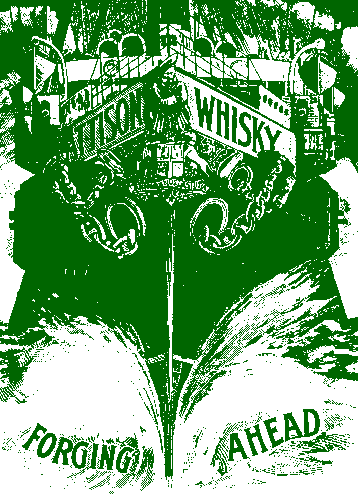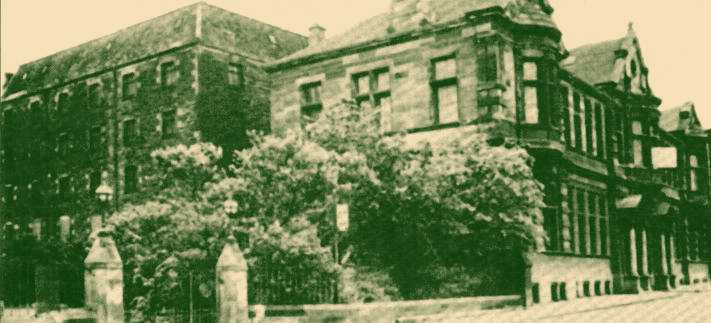The Day the Bubble Burst
 One enterprising candidate in the 1996Indian General Election trailed round his constituency with acage-full of green parakeets trained to intone his elecitonslogan. Exactly a hundred years earlier, the Pattison brothers -a couple of flashy and, as it transpired, dodgy Edinburgh whiskyentrepreneurs- were handing out to Scottish licensed grocers 500grey parrots that recited: "Buy Pattisons' Whisky."It's a hard truth for Marketing Man: there really is nothing newunder the sun.
One enterprising candidate in the 1996Indian General Election trailed round his constituency with acage-full of green parakeets trained to intone his elecitonslogan. Exactly a hundred years earlier, the Pattison brothers -a couple of flashy and, as it transpired, dodgy Edinburgh whiskyentrepreneurs- were handing out to Scottish licensed grocers 500grey parrots that recited: "Buy Pattisons' Whisky."It's a hard truth for Marketing Man: there really is nothing newunder the sun.
Robert and Walter Pattison attributed the meteoric success oftheir whisky blending empire to some "judiciousadvertising". They were certainly masters of the art. In oneyear, 1897, they are said to have paid out over £20,000 on aworld wide advertising campaign and three times that thefollowing year. "...advertising was resorted to on a scalepreviously undreamt of, "stated a contemporary newspaperreport. This in an age when it was already a fashionable medium.
Big brand names like Hovis, Beechams Pills, Nestle Swiss Milkand even Kodak daily wooed an eager public through the pages ofthe Scottish press. The Pattisons were ahead of the game, widelyadvertising their blends, "The Doctor" and "TheGordon". (Gordon of Khartoum in full dress uniform on thelabel - guaranteed to set Imperial hearts a-beating).
The Pattison family started in business in Edinburgh as dairywholesalers but were sharp enough to seize the chance of making afortune in whisky. In 1887 they went into partnership in theblending business and two years later made some £100,000 whenthe company was floated on the Stock Exchange.
They were creatures of their time: quick to exploit fashion,to take advantage of boom conditions in the whisky industry. Thebanks extended lavish credit and there was no shortage ofconfident - euphoric - investors. Against a backdrop of imperialgreatness, commercial Edinburgh and far beyond enjoyed a"feel good factor" that others might envy!
The brothers pushed the idea of conspicuous consumption to thevery limits. Their lavish lifestyles seemed to offer proof of thegreat wealth and outstanding business performance. Not contentwith palatial Edinburgh properties such as a vast house in LeithWalk and their marbled offices in Constitution Street (even theirwarehouse cost £60,000), they branched out into the life ofcountry gentlemen, with mansions and rolling acres in the Borders- at Clovenfords and Peebles.

Commuting from the country gave them the excuse for one oftheir favourite publicity stunts: the Missing of the Train. Theidea was to turn up late on the platform at Peebles or Galashielsand make a great commotion. When the local press was in positionthey would hire a private train at five pounds and a shilling amile to carry them to their pressing business engagements.
Their commercial expansion was no less astonishing. Theyacquired a half share in the Glenfarclas distillery, substantialinterests in the Oban and Aultmore-Glenlivet distillery and theArdgowan Lowland Grain distillery. The company also moved intobrewing, with the acquisition of the Duddingston Brewery. And allthis was largely done on borrowed money. It was an empire builton bank credit and considerable sleight of hand.
To raise money for their ventures, Walter and Robert soldstock then bought it back at inflated prices by obtaining billsof exchange which were later discounted. To keep their publicimage burning brightly, they resorted to over-valuing propertyand paying dividends out of capital. Nearly thirty years later,Walter Ross wrote that "...so large were their transactionsand so wide their ramifications that they infused into the Tradea reckless disregard of the most elementary rules of soundbusiness."
The more questionable side of their dealing didn't go entirelyunnoticed in contemporary commercial circles. There were rumoursand some uneasy mutterings. But it was boom time. Everyone withthe money to invest wanted to get richer - and these flamboyantbrothers seemed to be showing them the way.
With bank credit readily obtainable (by the mid 1890s Dewars'bank overdraft was £300,000, twice the amount of their sharecapital), "investors and speculators of the worst kind weredrawn into the vortex and vied with each other in their race ofriches." (Ironically it was a bank - the Clydesdale- thatpulled the plug on the Pattisons, refusing to pay a bill for£9,000).
New distilleries were built (thirty-three malt distilleries inthe 1890s alone) and new companies formed to buy out existingones. Many doubled or even trebled their output. There wasoverproduction on such a scale that years later its effects werestill being felt; stocks had been built up to an absurd level.Just under two million gallons of malt whisky was warehousedannually in 1891-2. By 1898-9 this had risen to thirteen and halfmillion gallons.
In December, 1898 the crash came. There had already been adownturn in the fortunes of the whisky industry and thePattisons' tactics could only succeed in times of expansion. Theimmediate affect of their downfall, according to The Scotsman atthe time, was probably gossip.
A story was running round Edinburgh that "the Company inthe end of last week pressed one of their customers to take up aparcel of whisky. He, thinking this a most unusual thing, is saidto have talked freely about it and the step in all probabilityreached the ears of the bank authorities."
However, that splendidly anecdotal writer on whisky, SirRobert Bruce Lockhart, thought the underlying cause was theScot's passion for gambling... "The general assumption thatthe Scot is afraid to take risks in business is erroneous. Noother race is more daring in speculation, and Scottish history isrich in examples of the disasters which overtook thoseget-rich-quick Scots who did not season speculation withcaution."
By co-incidence, the most heartbreaking failure in Scottishhistory had happened exactly two hundred years before. By 1696,the ill-fated Darien Company had a subscribed capital of a"respectable" £400,000 - exactly the same amount asthe capital of Pattisons (Ltd). Late The Scotsman was to write:"Not only was it Scottish money; it was the money of theScottish people. Rich and poor, Highlander and Lowlander, masterand servant, lord and loon - all were represented in the list ofcontributors which...took captive the whole Scottish heart."
The Darien project's failure was caused by tropical diseasenot incompetence or fraud and its subscribers were adventurousrather than adventurers. The affairs of the short-lived Pattisonsmay not have captured any hearts in its two years and nine monthsbut it claimed a lot of people's wallets - many close to theheart of the Scotch whisky industry.
On December 7th, 1898, under a discreet headline "TheStoppage of Pattisons (Ltd)" followed a column of masterlyunderstatement. "The affairs of Pattison (Ltd) was again thegeneral subject of discussion in commercial circles in Edinburghyesterday and, owing to the ramifications of the Company, therewas keen interest, in districts wide apart and extending all overthe kingdom, as to the outcome of the financial difficulties inwhich the Company is involved. These have been temporarilyarranged and the crisis may be said to be over for thepresent."
These measured words heralded the collapse of their glitteringempire after only two years and nine months. It was to vanishwithout trace. In 1896 they had floated their whisky blendingcompany, Pattisons (Ltd), with capital of £40,000. Two yearslater, on 6th December 1898, they ceased payment.
They took down with them nine other companies and scores ofsmall suppliers were forced out of existence. The amount claimedby creditors is believed to have totalled about £743,000. Threeyears later, Walter Gilchrist Gray Pattison and Robert Pattisonappeared in the Criminal Courts in front of the Lord JusticeGeneral on charges of fraudulent flotation, fraud andembezzlement. They received eight months and 18 monthsimprisonment respectively and never recovered.
The judgement of the industry in retrospect was that it was adisaster waiting to happen; that it would have happened anyway.By the year of the Pattison's crash there were 13.5 milliongallons of whisky in bond. Banks withdrew their credit and themarket was flooded. Other business collapses followed in quicksuccession.
But in the true tradition of the tortoise and the hare, awinner crept past the post. The DCL had weathered all thesestorms with comparative ease. Now the magnificent Pattisonwarehouses which had cost £60,000 came on the market. DCL pickedthem up for £25,000 and went quietly on their way from strengthto strength, as the established leaders.
Gillian Strickland
If you have comments about thissite, please contact the webmaster. All information in this site © The Scotch Malt WhiskySociety, Edinburgh, Scotland, 1997.
 One enterprising candidate in the 1996Indian General Election trailed round his constituency with acage-full of green parakeets trained to intone his elecitonslogan. Exactly a hundred years earlier, the Pattison brothers -a couple of flashy and, as it transpired, dodgy Edinburgh whiskyentrepreneurs- were handing out to Scottish licensed grocers 500grey parrots that recited: "Buy Pattisons' Whisky."It's a hard truth for Marketing Man: there really is nothing newunder the sun.
One enterprising candidate in the 1996Indian General Election trailed round his constituency with acage-full of green parakeets trained to intone his elecitonslogan. Exactly a hundred years earlier, the Pattison brothers -a couple of flashy and, as it transpired, dodgy Edinburgh whiskyentrepreneurs- were handing out to Scottish licensed grocers 500grey parrots that recited: "Buy Pattisons' Whisky."It's a hard truth for Marketing Man: there really is nothing newunder the sun. 